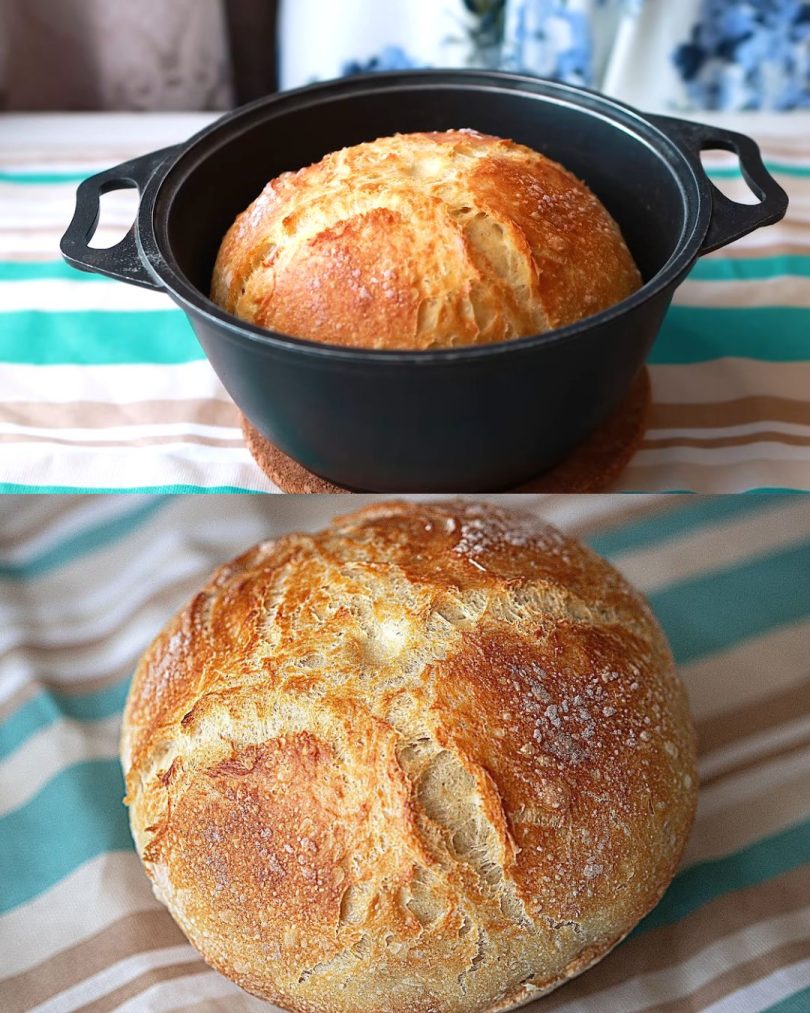ADVERTISEMENT
Activate the Yeast:
In a large mixing bowl, combine warm water (370 ml) and dry yeast (10 g). Stir gently and let it sit for 5-10 minutes, or until the yeast is fully dissolved and foamy.
Prepare the Dough:
Add the flour (500 g) and salt (1 teaspoon) to the yeast mixture. Mix with a wooden spoon or your hands until a rough dough forms.
Knead the Dough:
Transfer the dough to a lightly floured surface and knead for about 8-10 minutes, or until it becomes smooth and elastic. If the dough is too sticky, add a little more flour, one tablespoon at a time.
First Rise:
Place the dough in a clean, lightly oiled bowl, cover with a damp cloth, and let it rise in a warm place for about 1-2 hours, or until it has doubled in size.
Shape the Dough:
Punch down the risen dough to release any air bubbles. Shape it into a loaf or your desired form, and place it on a parchment-lined baking sheet or in a greased loaf pan.
Second Rise:
Cover the shaped dough with a cloth and let it rise again for 30-45 minutes, or until it has doubled in size.
Bake the Bread:
Preheat your oven to 200°C (400°F). Bake the bread for 25-30 minutes, or until the crust is golden brown and the loaf sounds hollow when tapped on the bottom.
Cool and Serve:
Remove the bread from the oven and let it cool on a wire rack before slicing. Enjoy your homemade bread warm or at room temperature!
Tips:
For a softer crust, brush the top of the loaf with melted butter after baking.
Add seeds or herbs to the dough for extra flavor.
Reasons to Love This Recipe
Easy to make with simple ingredients
Perfect for beginners
Soft, fluffy texture with a crispy crust
Versatile for different types of bread
Frequently Asked Questions (FAQs)
Can I use instant yeast instead of dry yeast?
Yes, you can use instant yeast. If using instant yeast, you can skip the activation step and mix it directly with the dry ingredients.
How do I know if my yeast is still active?
To check if your yeast is active, mix it with warm water and a pinch of sugar. If it becomes foamy and bubbly within 5-10 minutes, it’s active. If not, it may be expired, and you should use a fresh batch.
Can I make this bread gluten-free?
Yes, but you will need to use a gluten-free flour blend that is suitable for baking bread. Gluten-free doughs often need different handling and rising times, so adjust accordingly.
How can I make the crust softer?
To make the crust softer, brush the top of the bread with melted butter or cover it with a clean, damp cloth immediately after baking.
Can I add extra ingredients like seeds, nuts, or herbs?
Absolutely! Feel free to add seeds, nuts, or herbs to the dough during mixing for added flavor and texture.
What can I do if my dough is too sticky?
If your dough is too sticky, add a little more flour, one tablespoon at a time, until it reaches a smooth and elastic consistency.
How should I store the bread to keep it fresh?
Store the bread in a bread box or a sealed plastic bag at room temperature for up to 3 days. For longer storage, freeze it in an airtight container or freezer bag for up to 3 months.
Can I make the dough ahead of time?
Yes, you can make the dough ahead and refrigerate it after the first rise. Let it come to room temperature and rise again before shaping and baking.
Why did my bread turn out dense?
Dense bread can result from not kneading the dough enough, not allowing it to rise sufficiently, or using old yeast. Make sure to knead the dough until smooth and elastic and allow adequate rising time.
Can I bake this bread in a bread machine?
Yes, you can use a bread machine by following the manufacturer’s instructions for your specific model. Add ingredients in the order recommended by the machine, usually starting with wet ingredients followed by dry ingredients.
